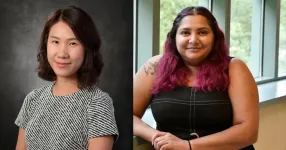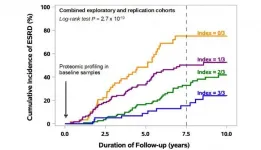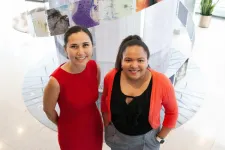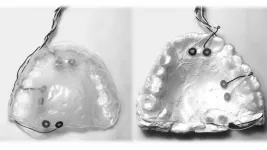(Press-News.org) June 30, 2021 - For most patients, the reasons for having a facelift are simple: to "turn back the clock" for a younger and more attractive appearance. Even during the pandemic year 2020, more than 234,000 patients underwent facelift surgery, according to American Society of Plastic Surgeons (ASPS) statistics.
When considering facelift surgery, patients may ask, "How much younger will I look?" For plastic surgeons, that has been a difficult question to answer. Typically, the cosmetic outcomes of facelifting have been judged on a case-by-case basis, or with the use of subjective ratings.
Now research suggests a new, objective approach to assessing the reduction in apparent age after facelift surgery: artificial intelligence (AI) networks trained to estimate age based on facial photos. "Our study shows that currently available AI algorithms can recognize the success of facelifting, and even put a number on the reduction in years of perceived age," comments senior author James P. Bradley, MD, Vice Chairman of Surgery, Zucker School of Medicine at Hofstra/Northwell. The study is published in the July issue of Plastic and Reconstructive Surgery®, the official medical journal of the ASPS.
The study used a type of AI algorithm called convolutional neural networks. "By training on datasets containing millions of public images, these neural networks can learn to discern facial features with much higher 'experience' than a typical person," Dr. Bradley explains.
Four different, publicly available neural networks were used to make objective age estimates of facial age for 50 patients who underwent facelifting. The AI estimates were made using standardized photos taken before and at least one year after facelift surgery. The results were compared with patients' subjective ratings of their appearance, along with responses to a standard patient-rated evaluation (FACE-Q questionnaire).
The patients were all women, average age 58.7 years. The AI algorithms used in the study were 100 percent accurate in identifying the patients' age, based on "before" photos.
In the "after" photos, the neural networks recognized a 4.3-year reduction in age after facelift surgery. That was substantially less than the 6.7-year reduction, as rated by patients themselves. "Patients may tend to overestimate how much younger they look after facelift surgery - perhaps reflecting their emotional and financial investment in the procedure," Dr. Bradley comments.
On the FACE-Q questionnaire, patients were highly satisfied with the results of their facelift surgery: average scores (on a 0-to-100 scale) were 75 for facial appearance and over 80 for quality of life. Neural network estimates of age reduction were directly correlated with patient satisfaction. "The younger the AI program perceives a patient's age, the greater their satisfaction with the results of their facelift," says Dr. Bradley.
Artificial intelligence algorithms can provide an objective and reliable estimate of the apparent reduction in age after facelift surgery, the new findings suggest. These age estimates also seem to provide an indicator of patient satisfaction scores - even if the reduction in years doesn't quite match the patient's own subjective rating.
"Together with powerful image analysis tools used in modern plastic surgery, neural networks may play a useful role in counseling patients and demonstrating successful results of facial rejuvenation procedures," Dr. Bradley adds. "We think that AI algorithms could also play a useful role for plastic surgeons in assessing their own results and comparing the outcomes of different techniques."
INFORMATION:
Click here to read "Turning Back the Clock: Artificial Intelligence Recognition of Age Reduction after Face-Lift Surgery Correlates with Patient Satisfaction."
DOI: 10.1097/PRS.0000000000008020
Plastic and Reconstructive Surgery® is published in the Lippincott portfolio by Wolters Kluwer.
About Plastic and Reconstructive Surgery
For over 75 years, Plastic and Reconstructive Surgery® (http://www.prsjournal.com/) has been the one consistently excellent reference for every specialist who uses plastic surgery techniques or works in conjunction with a plastic surgeon. The official journal of the American Society of Plastic Surgeons, Plastic and Reconstructive Surgery® brings subscribers up-to-the-minute reports on the latest techniques and follow-up for all areas of plastic and reconstructive surgery, including breast reconstruction, experimental studies, maxillofacial reconstruction, hand and microsurgery, burn repair and cosmetic surgery, as well as news on medico-legal issues.
About ASPS
The American Society of Plastic Surgeons is the largest organization of board-certified plastic surgeons in the world. Representing more than 7,000 physician members, the society is recognized as a leading authority and information source on cosmetic and reconstructive plastic surgery. ASPS comprises more than 94 percent of all board-certified plastic surgeons in the United States. Founded in 1931, the society represents physicians certified by The American Board of Plastic Surgery or The Royal College of Physicians and Surgeons of Canada.
About Wolters Kluwer
Wolters Kluwer (WKL) is a global leader in professional information, software solutions, and services for the clinicians, nurses, accountants, lawyers, and tax, finance, audit, risk, compliance, and regulatory sectors. We help our customers make critical decisions every day by providing expert solutions that combine deep domain knowledge with advanced technology and services.
Wolters Kluwer reported 2020 annual revenues of €4.6 billion. The group serves customers in over 180 countries, maintains operations in over 40 countries, and employs approximately 19,200 people worldwide. The company is headquartered in Alphen aan den Rijn, the Netherlands.
Wolters Kluwer provides trusted clinical technology and evidence-based solutions that engage clinicians, patients, researchers and students in effective decision-making and outcomes across healthcare. We support clinical effectiveness, learning and research, clinical surveillance and compliance, as well as data solutions. For more information about our solutions, visit https://www.wolterskluwer.com/en/health and follow us on LinkedIn and Twitter @WKHealth.
For more information, visit http://www.wolterskluwer.com, follow us on Twitter, Facebook, LinkedIn, and YouTube.
Electron motion in atoms and molecules is of fundamental importance to many physical, biological, and chemical processes. Exploring electron dynamics within atoms and molecules is essential for understanding and manipulating these phenomena. Pump-probe spectroscopy is the conventional technique. The 1999 Nobel Prize in Chemistry provides a well-known example wherein femtosecond pumped laser pulses served to probe the atomic motion involved in chemical reactions. However, because the timescale of electron motion within atoms and molecules is on the order of attoseconds (10-18 seconds) rather than femtoseconds (10-15 seconds), attosecond pulses are required to probe electron motion. With the development of ...
A recent University of Arizona College of Pharmacy study suggests that Objective Structured Clinical Examinations (OSCEs) may be a valuable means of assesing clinical skills while providing learning experiences for pharmacy students in community pharmacy settings. While the OSCEs were designed to assess health care professionals in a clinical setting, there was limited data on its use in testing skills required in community pharmacies, until now.
For pharmacists working in retail, guiding patients on the use of over-the-counter (OTC) drugs is a common part of the job. According to a recent survey from the American ...
Directing a meeting, dialing up an old acquaintance, dictating the perfect tuna salad sandwich across a drive-through window. For business and for pleasure, human beings are in constant communication.Our proclivity for socialization is lifelong, equally prominent in the lives of adolescents and adults. A recent study determined key differences in the ways that various age groups communicate, as well as one conversational component that stands the test of time: friendship. Specifically, bonds between individuals who identify as female.
Led by former Beckman Institute postdoctoral researchers Michelle Rodrigues and Si On Yoon, an interdisciplinary team evaluated how interlocutors' age and familiarity with one another impacts a conversation, reviewing the interaction's ...
Elevated levels of three specific circulating proteins are associated with protection against kidney failure in diabetes, according to research from the Joslin Diabetes Center that will be published 30th June in Science Translational Medicine.
"As well as acting as biomarkers for advancing kidney disease risk in diabetes, the proteins may also serve as the basis for future therapies against progression to the most serious types of kidney disease," said Andrzej S. Krolewski MD, PhD, senior author on the publication, senior investigator at Joslin Diabetes Center and professor of medicine ...
A 7- to 15-year longitudinal study of 358 diabetics has linked 3 proteins in blood with a slower progression of diabetic kidney disease and progressive kidney failure. The results from Zaipul Md Dom and colleagues suggest that the proteins could help researchers identify diabetics most at risk of kidney damage, potentially enabling earlier interventions and treatment. Despite advancements in blood sugar control and kidney therapies, patients with type 1 or type 2 diabetes still face a high risk of diabetic kidney disease. This condition can eventually progress to end-stage kidney disease, but some patients show slower kidney decline than others. In recent ...
Despite unprecedented advancements in technology and countless depictions of complex human-AI interactions in sci-fi movies, we have yet to fully achieve AI bots that can engage in conversation as naturally as humans can. Kushal Chawla, researcher at the USC Institute for Creative Technologies (ICT) and a doctoral student in computer science, along with collaborators at both the USC Information Sciences Institute (ISI) and ICT are taking us one step closer to this reality by teaching AI how to negotiate with humans.
The research, presented at the 2021 Annual Conference of ...
Although cardiovascular disease is the main cause of illness among women in the U.S., certain conditions such as coronary microvascular disease (CMD) cannot be easily diagnosed. In a new study, researchers at the University of Illinois Urbana-Champaign have identified specific biomarkers for CMD, which might reduce future hospitalizations.
CMD damages the inner walls of blood vessels causing spasms and decreased blood flow to the heart muscle. "Clinicians look for plaque formation in the blood vessels, which does not occur in CMD," said Zeynep Madak-Erdogan (CGD/EIRH/GSP), an associate professor of nutrition. "Usually, ...
The virus that gives rise to COVID-19 is the third coronavirus to threaten humanity in the past two decades. It also happens to move more efficiently from person to person than either SARS or MERS did. The first African case of COVID-19 was diagnosed in Egypt in mid-February of 2020. Four weeks later, the first lockdowns began across Africa. Steven Schiff, Brush Chair Professor of Engineering at Penn State, who already had established research partnerships in Uganda, saw an opportunity for his team to apply what they were learning from their ongoing efforts to track and control infectious disease and ...
Ten estuaries on the West Coast of North America have been identified as priority locations for expanding the use of conservation aquaculture in a study led by the Native Olympia Oyster Collaborative and funded by the Science for Nature and People Partnership (SNAPP). SNAPP is a research collaboration supported by the National Center for Ecological Analysis & Synthesis (NCEAS) at UC Santa Barbara.
The study, published in Plos One, recommends locations and methods for the strategic expansion of conservation aquaculture to bring back Olympia oyster populations -- both to local estuaries where they have most declined, and into more local restaurants for oyster lovers to dine on. The authors propose using aquaculture in these estuaries -- ...
Even the mundane act of swallowing requires a well-coordinated dance of more than 30 muscles of the mouth. The loss of function of even one of these, due to disease or injury, can be extremely debilitating. For these people, nerve stimulation offers a ray of hope to regain some of their lost oral function.
In a new study, researchers at Texas A&M University have delineated the minimum size of electrical currents needed to provide sensation in different parts of the mouth. The researchers said their study is a first but vital step toward building electrical stimulation implants that can restore essential intraoral functions that are lost due to nerve or brain damage.
The results of the study are published in the journal ...





